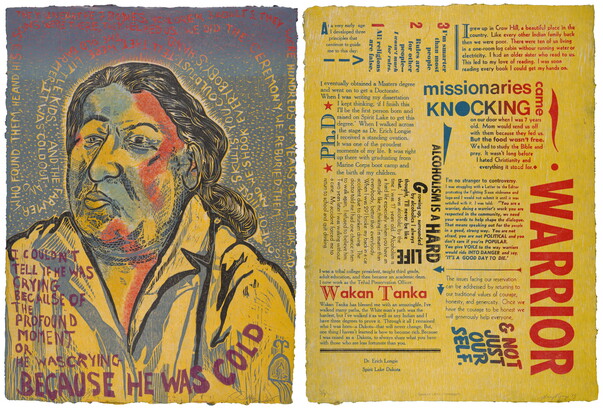

Artwork Image
Photo:
Controls
I Couldn't Tell if He was Crying
Object Details
-
Date
2015-2016
-
Object Type
Prints
-
Medium
Color reduction woodcut and letterpress on handmade mulberry and North Dakota native milkweed paper
-
Contributors
Printed by Kim Fink
-
Object Format
Diptych
-
Dimensions
19 3/8 x 52 1/4 in.
-
Credit Line
Amon Carter Museum of American Art, Fort Worth, Texas
-
Accession Number
2017.2.3
-
Copyright
© 2015-2016 Daniel Heyman and Lucy Ganje
Object Description
In 2015, Heyman traveled to North Dakota to chronicle the stories of those living within the state’s tribal nations. Ganje, a letterpress artist who grew up on the Cheyenne River Sioux Reservation in South Dakota, invited Heyman to meet with members of four nations: the Spirit Lake Tribe; the Turtle Mountain Band of Chippewa Indians; the Mandan, Hidatsa, and Arikara Nation; and the Standing Rock Sioux Tribe.
Heyman and Ganje are not Native American, but they worked in close collaboration with each nation’s tribal college, conducting extensive portrait sittings and interviews with 12 individuals selected by the colleges, which Heyman used as the basis of a series of woodcut portraits. In turn, Ganje created letterpress prints comprised of quotes from each interview recounting aspects of the sitter’s personal histories, values, and cultures. Collectively titled In Our Own Words, the collaborative project, printed by Kim Fink, provides first-person testimony that Indigenous cultures remain unique, rich, and very much alive.
—Text taken from the Carter Handbook (2023)
Additional details
Location: Off view
See more by Daniel Heyman
and
Lucy Ganje
Tags
-
Why might artists choose to collaborate on a work of art?
How might the choice to create a diptych affect the way in which a work of art is viewed and interpreted? How might unity be created in a diptych?
Why might an artist choose to include text in a work of art?
How has the purpose, media, and style of portraits changed and/or stayed the same throughout time?
How might the background, clothes, facial expression, and body language depicted in a portrait reveal something about the sitter?
How might the style, subject, and depiction of the sitter reveal something about the artist who created the portrait?
What kinds of relationships can exist between artist and subject, and how might those relationships impact the work of art?
-
Grades 1–3
Read the book The Star People: A Lakota Story by S.D. Nelson.
Grades 6–12
Have students take time to read the words that are in the artwork. Students will then take time to consider how they would want to be represented in a portrait and what story they would want to tell about their lives. Students will take a paper and fold it in half like a book. On one half of the paper, students will draw their own portrait and write words around the portrait that are important to them. These words could be things they say, their ideas or beliefs, or words that describe them. On the other half of the paper students can write a story they would want to share with others.
Share Educator Resources
Amon Carter Disclaimer
This information is published from the Carter's collection database. Updates and additions based on research and imaging activities are ongoing. The images, titles, and inscriptions are products of their time and are presented here as documentation, not as a reflection of the Carter’s values. If you have corrections or additional information about this object please email us to help us improve our records.
Every effort has been made to accurately determine the rights status of works and their images. Please email us if you have further information on the rights status of a work contrary or in addition to the information in our records.
Related Works
-
Angel of Death, 1959
Leonard Baskin
Woodcut
1971.25
-
Bread Line New York, 1932
Clare Leighton
Wood engraving
1985.289
-
That Language, 2015-2016
Daniel Heyman, Lucy Ganje
Color reduction woodcut and letterpress on handmade mulberry and North Dakota native milkweed paper
2017.2.10
-
When I Was President, 2015-2016
Daniel Heyman, Lucy Ganje
Color reduction woodcut and letterpress on handmade mulberry and North Dakota native milkweed paper
2017.2.13
-
Photograph Out of Context #7, 1980
Dean Dablow
Gelatin silver print
P1983.31.3
-
Sorrowing and Terrified Man, 1955
Leonard Baskin
Woodcut
1971.20
-
We Can Be Self-Sufficient, 2015-2016
Daniel Heyman, Lucy Ganje
Color reduction woodcut and letterpress on handmade mulberry and North Dakota native milkweed paper
2017.2.11
-
The Great Bird Man, ca. 1963
Leonard Baskin
Woodcut
1971.26
-
Torment, 1958
Leonard Baskin
Woodcut
1971.21

